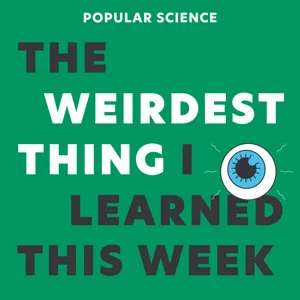Podcast Summary
Discovering Innovations in Agriculture and Home Services: AI and CRISPR technology boost food production, Angie's app simplifies hiring for home projects, and science continues to fascinate with new discoveries
Technology is revolutionizing various industries, from agriculture to home services, to make our lives more efficient and innovative. On the Tools and Weapons podcast, Microsoft's Brad Smith discusses with Bayer CEO Bill Anderson how AI and CRISPR technology are being used to increase food production without fertilizers. Meanwhile, Angie simplifies the process of hiring skilled professionals for home projects through their app and website. At Popular Science, the editors share their discoveries, from the most dedicated knuckle cracker to a deadly fashion trend, showcasing the endless fascination and knowledge that science brings.
Myths about knuckle cracking debunked: Over 50% of US population cracks knuckles daily, debunked myths include arthritis and growth stunting, popping sound caused by air bubble in synovial fluid, addictive nature of sound
Despite common beliefs, such as the idea that cracking knuckles causes arthritis or stunts growth, these beliefs are largely unfounded. Knuckle cracking is a popular activity with up to 54% of the US population engaging in it daily, and researchers have studied its effects extensively, with over 30 independent studies on the topic. The popping sound is caused by a bubble of air in synovial fluid, and the addictive nature of the sound is a common experience among those who engage in the behavior. While some people may believe that the bubble bursting causes the pop, others argue that it's the formation of the bubble that creates the sound. Regardless, the popping sensation is addictive and can be a source of enjoyment for many people.
Is Knuckle Cracking Linked to Arthritis?: Studies and personal experiments have debunked the myth that knuckle cracking causes arthritis.
Despite the common belief that knuckle cracking causes arthritis, numerous observational studies and personal experiments have shown no correlation between the two. Rachel and the speaker have different favorite body parts to crack and find the sensation satisfying, while some people find the sound jarring and even compare it to scratching on a chalkboard. The belief that knuckle cracking leads to arthritis likely originated from the jarring sound, but studies have debunked this myth. For instance, a study published in the Annals of Rheumatic Diseases in 1990 found no difference in arthritis rates between habitual knuckle crackers and non-crackers. Similarly, Donald Unger, who was warned against knuckle cracking as a child, conducted a 50-year self-experiment and found no arthritis in either hand. While more research may be necessary to confirm these results, the current evidence suggests that knuckle cracking does not lead to arthritis.
No proven link between knuckle cracking and arthritis: Decades-long study found no link between knuckle cracking and arthritis, despite common belief
There is no proven link between knuckle cracking and the development of finger conditions like arthritis, based on a self-funded study conducted by Dr. Donald Unger over several decades. The discipline required to crack only one hand is remarkable. Additionally, while there have been reported injuries from attempting to crack knuckles, these appear to be rare and unintentional. Moving on, another intriguing topic is the potential health risks associated with wearing thin Muslim dresses, which gained popularity among the wealthy after the French Revolution. This fashion trend, despite its absurdity, may have contributed to a health epidemic due to the cold weather and lack of coverage. The post-revolution era saw a resurgence of wealth and strange subcultures, leading to the adoption of these thin dresses, despite the health risks.
19th century fashion blamed for tuberculosis spread: Despite no solid evidence, societal norms and satirical cartoons linked thin, clingy 19th century fashion to the spread of tuberculosis, contributing to the glorification of death and beauty standards.
In the 19th century, European women's fashion trends shifted towards thin, clingy dresses, which were blamed for contributing to the spread of tuberculosis due to the belief that women often wore damp dresses. However, there is no solid evidence to support this claim, and it was more likely a result of satirical cartoons and societal norms of the time. The fashion trend was also linked to the glorification of death and beauty standards, as tuberculosis, or consumption, was reaching epidemic levels due to crowded living conditions and lack of sanitation. Despite the misconception, tuberculosis was not limited to the upper class and was easily transmitted through coughing and spit. Doctors also believed that certain physical characteristics, such as thinness, pale skin, red lips, and bright eyes, made individuals more susceptible to tuberculosis due to long-term low-grade fevers.
Romanticizing Tuberculosis: A Disease of Beauty and Passion: Once romanticized as a sign of beauty and passion, TB was later understood to be a serious health issue that required different approaches to prevent its spread
Tuberculosis (TB) was once romanticized and glamorized as a disease of beautiful, passionate young women in the 19th century. This belief originated from the physical symptoms of TB, such as pale skin, rosy cheeks, and bright eyes, which were seen as signs of beauty and passion. Poets like Lord Byron contributed to this idea, as they idealized the sickly, weak, and pale appearance. This led to the rise of "Consumptive Chic," a fashion trend where women tried to achieve the sickly look through various means like corsets, arsenic, and belladonna drops. The disease was also seen as a sign of wealth and privilege, as it was more common among the upper class. However, as more was learned about TB and its causes, it became associated with poverty and germs, leading to a shift in fashion trends. In summary, tuberculosis was once romanticized as a disease of beauty and passion, but it was later understood to be a serious health issue that required different approaches to prevent its spread.
Fashion's fascination with death and sickness during the Victorian era: The fashion industry's power to set trends and influence society has led to the popularization of uncomfortable and often impractical styles, with the Victorian era's obsession with death and sickness resulting in trends like pale complexions and high waisted corsets, which continue to resurface in modern high fashion.
The obsession with death and sickness during the Victorian era significantly influenced fashion trends, particularly the idealization of women on the brink of death. This fascination led to the popularity of trends like pale complexions, high waisted corsets, and the romanticization of consumptive women in art and poetry. The trend extended beyond the Victorian era and can still be seen in modern high fashion, albeit in a less extreme form. The fashion industry's ability to set trends and influence society remains a powerful force, with uncomfortable and often impractical styles becoming the norm. The current trend of high waisted jeans, such as Levi's new "rib cage jeans," can be seen as a modern example of this top-down effect. The fashion system's power to dictate what is considered desirable and trendy continues to shape our culture and influence our daily lives.
Exploring the quest for comfortable shapewear and the obscure anatomical term 'pouch of Douglas': Both shapewear and anatomy challenge societal norms, leading to innovations and new discoveries through questioning and exploration.
There's a ongoing quest for comfortable and effective shapewear, as the speaker shared her experience with a girdle-like product that worked well but was uncomfortable, much like traditional girdles. Meanwhile, in a completely different context, Hannah Gadsby's stand-up routine introduced the audience to an obscure anatomical term, the pouch of Douglas, a space between the rectum and vagina, named after a Scottish midwife, James Douglas. The historical context involved Douglas's feminist approach to midwifery and his public dissections of female cadavers, which was a common practice during that time. Despite their vast differences, both topics illustrate the importance of questioning norms and challenging societal expectations, whether it's in the realm of fashion or anatomy.
The Pouch of Douglas: A Newly Discovered, Potentially Significant Area in Gynecology: The Pouch of Douglas, a previously understudied region between the uterus and rectum, may indicate conditions like endometriosis and ectopic pregnancies, adding to the body's complexity and efficiency.
The Pouch of Douglas, a previously understudied region in the female body, is gaining more attention from medical professionals due to its potential role in detecting serious gynecological issues. This space, located between the uterus and the rectum, allows other organs to expand and slide by, providing cushion and support. Although it doesn't have a specific function itself, it may indicate conditions such as endometriosis and ectopic pregnancies. The Pouch of Douglas is an intriguing discovery, adding to the complexity and efficiency of the human body. Previously dismissed as insignificant, recent research suggests that it might have more uses and functions than initially thought. This underscores the importance of continued investigation into lesser-known areas of the human body.
New discoveries in human body functions and organ identification: Recent research reveals that appendectomies may be avoided, a new organ called mesentery was discovered, and it's crucial to stay informed, open-minded, and maintain our homes for good health.
Our understanding of the human body and its functions continues to evolve, with new discoveries and research leading to new insights and potential advancements in medical care. For instance, there is ongoing research into how often appendectomies can be avoided through the use of biometrics. Additionally, there are still many things about the human body that remain a mystery. Another interesting takeaway from the discussion was the discovery of a new organ, the mesentery, which was once believed to be just a collection of disconnected tissues. This finding challenges long-held beliefs and demonstrates the importance of continued research and exploration. Furthermore, the discussion highlighted the importance of being informed and open-minded when it comes to our health and wellbeing. It's essential to be aware of potential health risks and symptoms, but it's also important not to jump to conclusions or self-diagnose based on limited information. Finally, the discussion touched on the importance of maintaining our homes and taking care of everyday maintenance and repairs. Utilizing services like Angie's List can help simplify the process and ensure that projects are completed efficiently and effectively. Overall, the Weirdest Thing I Learned This Week podcast provides a fascinating and often humorous exploration of the latest scientific discoveries and medical research. It's a great reminder of the importance of continued learning and the wonders of the world around us.



